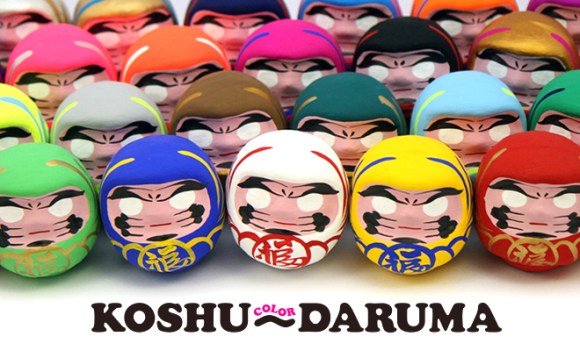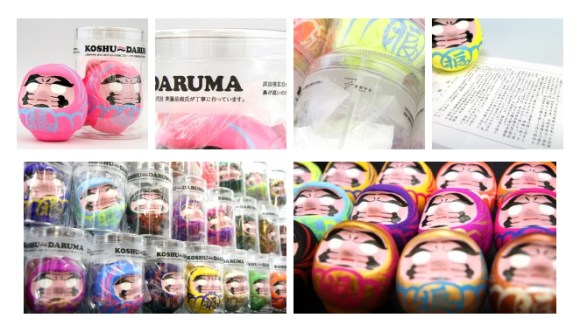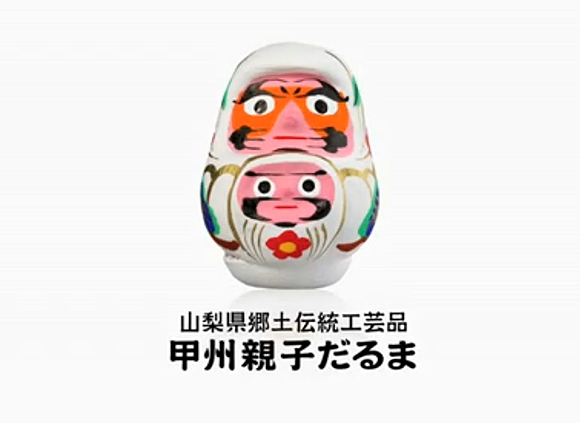
How much do you know about daruma? Historically, there was the man called Daruma-daishi (aka Bhodhidharma), a Buddhist monk who is credited with spreading the practice of Zen Buddhism into China. Then, there are the daruma dolls, paper mache prayer tokens made and distributed throughout Japan for the sake of health, longevity, and success. These limbless dolls have an approximate 400-year history of bringing encouragement and good fortune to the people of Japan. However, in recent years the production and subsequent purchase of daruma has fallen. People are losing track of their daruma dolls, forgetting the purpose for which they serve, or at a loss of where to buy them in the first place.
Now, in an effort to bring back appreciation for the humble daruma, the Kagoyaka company in Yamanashi Prefecture is modernizing the traditional doll into something they call the Koshu~Color Daruma.
The tradition of keeping daruma dolls as good luck tokens originated in Gunma Prefecture, though the creation and sale of these bearded ornaments has since spread to many regions throughout Japan. Although every region decorates their daruma in a slightly different fashion, the symbolism remains basically the same. The eyebrows of the daruma are painted in the shape of a crane, while the beard mimics the shell of a tortoise–both animals which embody longevity, thus blessing the family who owns the doll with long and healthy lives. The main purpose of a daruma, however is to help its owner achieve much more specific goals.
When a daruma is first sold, the eyes are purposefully left empty and white. The owner fills in one eye of the daruma and puts the piece on display until their goal is achieved. Seeing the one-eyed daruma is meant to act as a reminder that one’s work is unfinished and one must continue to strive for achievement. Another explanation for this practice is that the daruma itself holds some level of power over the world and that promising to fill in the daruma’s second eye upon the realization of a person’s goals will motivate the daruma to grant his or her wish.
The color of a daruma also holds some special meaning, in that different colored daruma are said to bring good fortune to different aspects of a person’s everyday life. For example, red is universally accepted as the color of victory, making it the color of choice for politicians hoping to win their campaigns. Gold, on the other hand, always symbolizes financial gain and stability. Daruma come in many colors besides these, though the symbolic meaning often varies depending on the region.
For one daruma production company in Yamanashi, this correlation between color and appropriate request was seen as too limiting to sell in this modern age. That’s why the Kogayaka company has created the Koshu~Color Daruma in 30 different color variations! They encourage customers to wish whatever they like upon the daruma most suited to their tastes. This high selection of styles wrapped up in a very modern-looking package design is expected to inspire a new surge in daruma sales, hopefully inspiring people to look into the more traditional Koshu daruma styles and techniques as well. It is important to the people who produce these daruma that the story and the history behind the bearded doll be protected and perpetuated for many generations to come.
Source: Excite News (Japanese)
Images: Kagayaka
▼ Koshu~Color Daruma stand approximately seven centimeters (2.8 inches) tall and sell for 1,260 yen (US$12.62) each.
▼ For expecting mothers, Kagayaka also offers an Oyako Daruma (mother and child daruma) with a bearded baby face over the belly of a mother daruma. This is meant to ensure the safety and prosperity of one’s future offspring.




 Japanese festival says thank you and goodbye to daruma good-luck dolls…with fire【Photos】
Japanese festival says thank you and goodbye to daruma good-luck dolls…with fire【Photos】 Visit the birthplace of the Japanese daruma in Gunma Prefecture
Visit the birthplace of the Japanese daruma in Gunma Prefecture Special Totoro good-luck noren tapestries usher good fortune and cuteness into your home【Pics】
Special Totoro good-luck noren tapestries usher good fortune and cuteness into your home【Pics】 We revisited Sweets Paradise after a decade to see if Japan’s dessert buffet still delivers
We revisited Sweets Paradise after a decade to see if Japan’s dessert buffet still delivers Why buy a new car when you could get this life-sized anime girl statue for the same price?
Why buy a new car when you could get this life-sized anime girl statue for the same price? Hayao Miyazaki says Happy New Year to Studio Ghibli fans with new art for Year of the Horse
Hayao Miyazaki says Happy New Year to Studio Ghibli fans with new art for Year of the Horse Starbucks Japan ready to get Year of the Horse started with adorable drinkware and plushies【Pics】
Starbucks Japan ready to get Year of the Horse started with adorable drinkware and plushies【Pics】 7 great places to see Mt. Fuji from without having to climb it
7 great places to see Mt. Fuji from without having to climb it Check out this 8m robot that appeared on Tokyo’s waterfront【Video】
Check out this 8m robot that appeared on Tokyo’s waterfront【Video】 Japan’s otoshidama tradition of giving kids money at New Year’s gets a social welfare upgrade
Japan’s otoshidama tradition of giving kids money at New Year’s gets a social welfare upgrade 7 hilarious/inexplicable Japan moments in South Park
7 hilarious/inexplicable Japan moments in South Park Pizza Hut Japan’s hot lucky bags are perfect for a New Year’s pizza party
Pizza Hut Japan’s hot lucky bags are perfect for a New Year’s pizza party New heater-less pet kotatsu is a safe way to keep your furry friends warm this winter
New heater-less pet kotatsu is a safe way to keep your furry friends warm this winter 7-Eleven Japan’s ramen-cooking robot whipped us up a bowl of noodles【Taste test】
7-Eleven Japan’s ramen-cooking robot whipped us up a bowl of noodles【Taste test】 Cyberpunk anime meets traditional culture in Ghost in the Shell gold leaf Japanese changing screens
Cyberpunk anime meets traditional culture in Ghost in the Shell gold leaf Japanese changing screens Hello Kitty Choco Egg figures are an adorable trip through three periods of Japanese pop culture【Pics】
Hello Kitty Choco Egg figures are an adorable trip through three periods of Japanese pop culture【Pics】 We found possibly the quietest Japanese-style hotel in Tokyo’s bustling Shinjuku district
We found possibly the quietest Japanese-style hotel in Tokyo’s bustling Shinjuku district Lacquerware supplier to emperor of Japan and Pokémon team up for new tableware
Lacquerware supplier to emperor of Japan and Pokémon team up for new tableware Sumo Sanrio! Hello Kitty and pals team up with Japan Sumo Association for new merch【Pics】
Sumo Sanrio! Hello Kitty and pals team up with Japan Sumo Association for new merch【Pics】 Can a dirty butthole make you filthy rich in Japan? We’re starting a New Year’s lottery experiment
Can a dirty butthole make you filthy rich in Japan? We’re starting a New Year’s lottery experiment 7-Eleven Japan starts new temporary luggage storage service in over 300 branches
7-Eleven Japan starts new temporary luggage storage service in over 300 branches Disillusionment at Tsukiji’s tourist-target prices led us to a great ramen restaurant in Tokyo
Disillusionment at Tsukiji’s tourist-target prices led us to a great ramen restaurant in Tokyo Starbucks teams up with 166-year-old Kyoto doll maker for Year of the Horse decorations【Photos】
Starbucks teams up with 166-year-old Kyoto doll maker for Year of the Horse decorations【Photos】 Tokyo considering law requiring more trash cans following litter increase in heavily touristed area
Tokyo considering law requiring more trash cans following litter increase in heavily touristed area Tokyo’s Tsukiji sushi neighborhood asks tour groups to stay away for the rest of the month
Tokyo’s Tsukiji sushi neighborhood asks tour groups to stay away for the rest of the month Nintendo’s Kirby now delivering orders at Kura Sushi restaurants, but not in Japan
Nintendo’s Kirby now delivering orders at Kura Sushi restaurants, but not in Japan Tokyo event lets you travel back in time, for free, to celebrate 100 years since Showa era start
Tokyo event lets you travel back in time, for free, to celebrate 100 years since Showa era start Sanrio theme park in Japan announces plans to expand into a Sanrio resort
Sanrio theme park in Japan announces plans to expand into a Sanrio resort Japan may add Japanese language proficiency, lifestyle classes to permanent foreign resident requirements
Japan may add Japanese language proficiency, lifestyle classes to permanent foreign resident requirements Survey asks foreign tourists what bothered them in Japan, more than half gave same answer
Survey asks foreign tourists what bothered them in Japan, more than half gave same answer Japan’s human washing machines will go on sale to general public, demos to be held in Tokyo
Japan’s human washing machines will go on sale to general public, demos to be held in Tokyo Japan’s deadliest food claims more victims, but why do people keep eating it for New Year’s?
Japan’s deadliest food claims more victims, but why do people keep eating it for New Year’s? We deeply regret going into this tunnel on our walk in the mountains of Japan
We deeply regret going into this tunnel on our walk in the mountains of Japan Studio Ghibli releases Kodama forest spirits from Princess Mononoke to light up your home
Studio Ghibli releases Kodama forest spirits from Princess Mononoke to light up your home Major Japanese hotel chain says reservations via overseas booking sites may not be valid
Major Japanese hotel chain says reservations via overseas booking sites may not be valid Put sesame oil in your coffee? Japanese maker says it’s the best way to start your day【Taste test】
Put sesame oil in your coffee? Japanese maker says it’s the best way to start your day【Taste test】 No more using real katana for tourism activities, Japan’s National Police Agency says
No more using real katana for tourism activities, Japan’s National Police Agency says Starbucks Japan reveals new sakura drinkware collection, inspired by evening cherry blossoms
Starbucks Japan reveals new sakura drinkware collection, inspired by evening cherry blossoms Updated cherry blossom forecast shows extra-long sakura season for Japan this year
Updated cherry blossom forecast shows extra-long sakura season for Japan this year
Leave a Reply